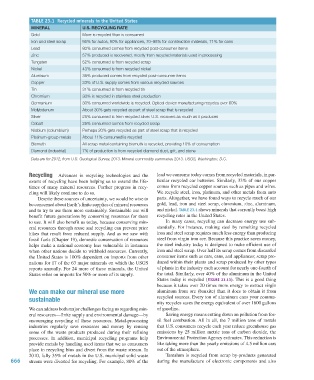Page 667 - Environment: The Science Behind the Stories
P. 667
TAble 23.1 recycled minerals in the united States
MinErAL U.S. rECyCLing rATE
Gold More is recycled than is consumed
Iron and steel scrap 95% for autos, 90% for appliances, 70–98% for construction materials, 71% for cans
Lead 80% consumed comes from recycled post-consumer items
Zinc 57% produced is recovered, mostly from recycled materials used in processing
Tungsten 52% consumed is from recycled scrap
Nickel 43% consumed is from recycled nickel
Aluminum 35% produced comes from recycled post-consumer items
Copper 33% of U.S. supply comes from various recycled sources
Tin 31% consumed is from recycled tin
Chromium 30% is recycled in stainless steel production
Germanium 30% consumed worldwide is recycled. Optical device manufacturing recycles over 60%
Molybdenum About 30% gets recycled as part of steel scrap that is recycled
Silver 25% consumed is from recycled silver. U.S. recovers as much as it produces
Cobalt 25% consumed comes from recycled scrap
Niobium (columbium) Perhaps 20% gets recycled as part of steel scrap that is recycled
Platinum-group metals About 11% consumed is recycled
Bismuth All scrap metal containing bismuth is recycled, providing 10% of consumption
Diamond (industrial) 7% of production is from recycled diamond dust, grit, and stone
Data are for 2012, from U.S. Geological Survey, 2013. Mineral commodity summaries 2013. USGS, Washington, D.C.
Recycling Advances in recycling technologies and the lead we consume today comes from recycled materials, in par-
extent of recycling have been helping us to extend the life- ticular recycled car batteries. Similarly, 33% of our copper
times of many mineral resources. Further progress in recy- comes from recycled copper sources such as pipes and wires.
cling will likely continue to do so. We recycle steel, iron, platinum, and other metals from auto
Despite these sources of uncertainty, we would be wise to parts. Altogether, we have found ways to recycle much of our
be concerned about Earth’s finite supplies of mineral resources gold, lead, iron and steel scrap, chromium, zinc, aluminum,
and to try to use them more sustainably. Sustainable use will and nickel. TAble 23.1 shows minerals that currently boast high
benefit future generations by conserving resources for them recycling rates in the United States.
to use. It will also benefit us today, because conserving min- In many cases, recycling can decrease energy use sub-
eral resources through reuse and recycling can prevent price stantially. For instance, making steel by remelting recycled
hikes that result from reduced supply. And as we saw with iron and steel scrap requires much less energy than producing
fossil fuels (Chapter 19), domestic conservation of resources steel from virgin iron ore. Because this practice saves money,
helps make a national economy less vulnerable in instances the steel industry today is designed to make efficient use of
when other nations decide to withhold resources. Currently, iron and steel scrap. Over half its scrap comes from discarded
the United States is 100% dependent on imports from other consumer items such as cars, cans, and appliances; scrap pro-
nations for 17 of the 63 major minerals on which the USGS duced within their plants and scrap produced by other types
reports annually. For 24 more of these minerals, the United of plants in the industry each account for nearly one-fourth of
States relies on imports for 50% or more of its supply. the total. Similarly, over 40% of the aluminum in the United
States today is recycled (Figure 23.13). This is a good thing
because it takes over 20 times more energy to extract virgin
We can make our mineral use more aluminum from ore (bauxite) than it does to obtain it from
sustainable recycled sources. Every ton of aluminum cans your commu-
nity recycles saves the energy equivalent of over 1600 gallons
We can address both major challenges facing us regarding min- of gasoline.
eral resources—finite supply and environmental damage—by Saving energy means cutting down on pollution from fos-
encouraging recycling of these resources. Metal-processing sil fuel combustion. All in all, the 7 million tons of metals
industries regularly save resources and money by reusing that U.S. consumers recycle each year reduce greenhouse gas
some of the waste products produced during their refining emissions by 25 million metric tons of carbon dioxide, the
processes. In addition, municipal recycling programs help Environmental Protection Agency estimates. This reduction is
provide metals by handling used items that we as consumers like taking more than the yearly emissions of 4.5 million cars
place in recycling bins and divert from the waste stream. In out of the atmosphere.
2010, fully 35% of metals in the U.S. municipal solid waste Tantalum is recycled from scrap by-products generated
666 stream were diverted for recycling. For example, 80% of the during the manufacture of electronic components and also
M23_WITH7428_05_SE_C23.indd 666 13/12/14 11:29 AM

